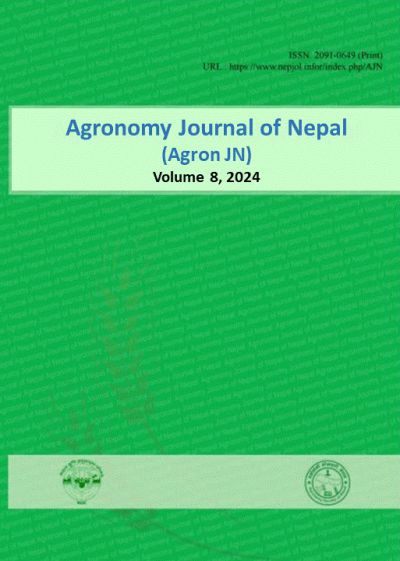Response of Mungbean (Vigna radiata L. Wilczek) to Rhizobium inoculation and Irrigation Schedule in Siraha, Nepal
DOI:
https://doi.org/10.3126/ajn.v8i1.70795Keywords:
Irrigation, Mungbean, Productivity, RhizobiumAbstract
Mungbean (Vigna radiata L.) productivity in Nepal is indeed lower compared to its potential yield due to inadequate nutrient management and soil moisture depletion. Use of effective plant growth promoting bacteria and proper irrigation scheduling in mungbean can enhance its production and productivity. To study the response of Rhizobium inoculation and irrigation schedule on growth and yield of mungbean, a field experiment was conducted in a split-plot field layout at a farmers' field in Dhangadimai Municipality, Siraha, Nepal from March 2023 to June 2023. The treatments consisted of four levels of irrigation (i.e. Rainfed, Irrigation at vegetative stage (V), irrigation at reproductive stage (R) and irrigation at both (V and R) in main plots and two levels of biofertilizer (with and without Rhizobium inoculation) in sub plots which was replicated three times. Plant height, leaf numbers, number of effective branches, pod length, and grain per pod were recorded highest in mungbean inoculated with rhizobium, and irrigation at both V and R stages. The highest grain yield (1.81 Mtha-1) was obtained from the treatment having irrigation at both V and R stages, followed by irrigation scheduled at R (1.56 Mtha-1), V (1.47 Mtha-1), and rainfed condition (1.34 Mtha-1). The grain yield was higher in inoculated (1.58 Mtha-1) than in non-inoculated mungbean (1.50 Mtha-1). Rhizobium inoculated crops irrigated during V stage only, irrigated during R stage only and irrigated at both V and R stages increased grain yield by 6.32%, 5% and 17% respectively as compared to rainfed conditions. Number of effective nodules per plant was 79 % higher in inoculated (15.72) than in non-inoculated plots (4). The best combination was found in the treatment where irrigation was applied in both V and R stages with Rhizobium inoculation. Thus, application of rhizobium inoculation and irrigation at V and R stages showed a positive response to growth parameters, yield attributing characters, and yield.
Downloads
Downloads
Published
How to Cite
Issue
Section
License
Copyright (c) 2024 Agronomy Society of Nepal (ASoN)

This work is licensed under a Creative Commons Attribution-NonCommercial 4.0 International License.
ASON permits for free use, distribution and reproduction in any medium if the original work is properly cited and not used for commercial purposes.




